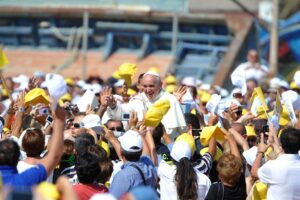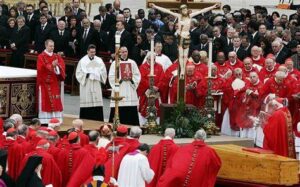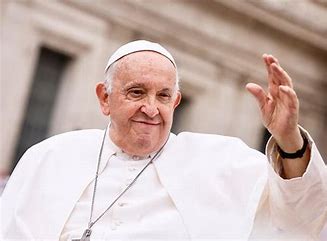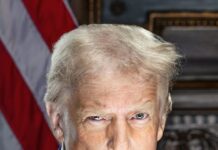On the morning of April 21, 2025, Camerlengo Cardinal Kevin Farrell announced that Pope Francis had passed away. Pope Francis, the first Latin American and Jesuit pope, served a twelve-year pontificate beginning in 2013. His death comes after an extended stay in the hospital being treated for double Pneumonia. During his pontificate, he tackled many issues of social justice such as immigration and poverty. He also led the church through the historic COVID-19 pandemic, giving Catholics hope in a time of great suffering. His pontificate is one that is truly unique and one that will be remembered for a long time.
Journey to the Papacy
Pope Francis, named Jorge Mario Bergoglio, was born in Buenos Aries, Argentina on December 17, 1936. He was the eldest of five children, and a gifted scholar. Bergoglio joined the Jesuits in 1958 and was ordained a priest in 1969. In 1997, he was named Coadjutor Archbishop of Buenos Aires and assumed full leadership of the Archdiocese the following year. He was known as a very humble bishop, opting to use public transportation while living in a small apartment. In 2001, Pope John Paul II elevated Bergoglio to the College of Cardinals, setting him up for his eventual ascent to papacy. Following the shocking resignation of Pope Bendict XVI, he was elected pope on March 13, 2013, taking the name Francis.
Papacy
Pope Francis tackled many issues during his papacy, some of which made him a very controversial figure among Catholics. For example, he took a more inclusive stance toward LGBTQ+ Catholics. Early in his papacy he was asked a question about gay priests, to which he remarked “who am I to judge,” marking a shift from the attitude of his predecessors. Additionally, he gave permission of priests to give blessings to same-sex couples in 2023.
He also took great care for migrants. In July of 2013, he traveled to the Italian island of Lampedusa, a key entry points for migrants crossing into the Mediterranean from North Africa. There, he highlighted the conditions of those who left their home to seek a better life. Additionally, he harshly criticized the stance of President Donald Trump, most recently in a letter to Catholic Bishops in the United States.

Another issue he tackled during his papacy was the clergy sex-abuse crisis. He convened a summit 2019 for the protection of minors, setting protocols aimed at greater accountability. He apologized to survivors of the Irish Abuse and in 2022, visited Canada to apologize for the church-run residential schools that traumatized generations of Indigenous Americans.
The World Reacts
Many people like myself woke up shocked on Easter Monday to the news of Pope Francis’ death. However, the many world leaders also reacted. Vice President JD Vance, who met with Pope Francis on Easter Sunday, posted on X (formerly Twitter):
“My heart goes out to the millions of Christians all over the world who loved him.”
“I was happy to see him yesterday (Sunday), though he was obviously very ill. But I’ll always remember him for the…homily he gave in the very early days of COVID. It was really quite beautiful.”
Additionally, President Donald Trump, who at times came into disagreement with Pope Francis, stated on Truth Social: “Rest in Peace Pope Francis! May God Bless him and all who loved him!”
President Emmanual Macron of France stated “from Buenos Aires to Rome, Pope Francis wanted the Church to bring joy and hope to the poorest. For it to unite humans among themselves, and with nature. May this hope forever outlast him.”
Javier Milei, the President of Argentina, stated, “It is with profound sorrow that I learned this sad morning that Pope Francis, Jorge Bergoglio, passed away today and is now resting in peace. Despite differences that seem minor today, having been able to know him in his goodness and wisdom was a true honor for me.”
What’s Next?
Following the pronouncement of the pope’s death, a nine-day mourning period called Novemdiales will commence. Four to six days after Francis’ death, his funeral will be held. Francis has asked to be buried under Rome’s St. Mary Major Basilica in a simple wooden casket. During the nine-day period, cardinals will start to gather for the Conclave and make their pitches to other cardinals on visions for the church.

Behind closed doors, all eligible cardinals will cast their votes for the next pope. To be eligible, a cardinal must be under the age of 80. To secure the papacy, a cardinal must achieve a two-thirds-plus-one majority. Ballots will be cast repeatedly until a pope is elected. The longest conclave lasted 33 years, resulting in the election of Pope Gregory X. The shortest one lasted less than 24 hours, resulting in the election of Pope Pius XII. After each round of voting, the paper ballots are burned, creating the iconic “black smoke” indicating that a pope has not been chosen. However, Catholics wait for white smoke and the words “Habemus Papam,”signaling a new pope and a new era for the church.
Sources: Newsweek, CBS News, EWTN, USA Today, Reuters
Stay tuned to The Roundup for updates on the status of the Conclave!






